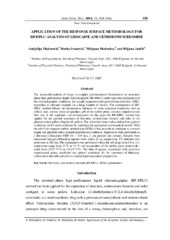Приказ основних података о документу
Application of the response surface methodology for RP-HPLC analysis of lidocaine and cetrimonium bromide
| dc.creator | Malenović, Anđelija | |
| dc.creator | Ivanović, Darko | |
| dc.creator | Medenica, Mirjana | |
| dc.creator | Jančić, Biljana | |
| dc.date.accessioned | 2019-09-02T10:59:10Z | |
| dc.date.available | 2019-09-02T10:59:10Z | |
| dc.date.issued | 2004 | |
| dc.identifier.issn | 1318-0207 | |
| dc.identifier.uri | https://farfar.pharmacy.bg.ac.rs/handle/123456789/522 | |
| dc.description.abstract | The successful analysis of drugs in complex pharmaceutical formulations by reversed-phase high performance liquid chromatography (RP-HPLC) relies upon the optimization of the chromatographic conditions, the sample preparation and post-column detection. HPLC separation of mixtures depends on a large number of factors. The optimization of RP-HPLC method defines the simultaneous influence of some important conditions, such as column type, mobile phase composition, pH of the mobile phase, column temperature and flow rate, to the separation and determination. In this paper the RP-HPLC method was applied for the optimal separation of lidocaine, cetrimonium bromide and color in the pharmaceutical pellets (Septalen(R) pellets). The selectivity factor values defined the optimal conditions, which were confirmed by analyzing the appropriate mathematical models. With the aid of the response surface methodology (RSM) it was possible to anticipate to a certain degree and precisely select optimal experimental conditions. Separations were performed on a Beckman Ultrasphere ODS 4.6 x 150 mm, 5 mum particle size column. Samples were introduced through a Rheodyne injector valve with a 20 muL sample loop. UV detection was performed at 208 nm. The optimization was performed within the pH range from 2.0 to 5.5; temperature range from 20 degrees C to 55 degrees C and composition of the mobile phase acetonitrile water from (15:85 V/V) to (35:65 V/V). The three-D graphs, constructed with sixty-four experimental points, confirmed the optimal conditions for the separation of lidocaine, cetrimonium bromide and color in analyzed pharmaceutical preparations. | en |
| dc.publisher | Slovensko Kemijsko Drustvo, Ljubljana | |
| dc.rights | openAccess | |
| dc.rights.uri | https://creativecommons.org/licenses/by/4.0/ | |
| dc.source | Acta Chimica Slovenica | |
| dc.subject | lidocaine | en |
| dc.subject | cetrimonium bromide | en |
| dc.subject | RP-HPLC | en |
| dc.subject | RSM | en |
| dc.subject | optimization | en |
| dc.title | Application of the response surface methodology for RP-HPLC analysis of lidocaine and cetrimonium bromide | en |
| dc.type | article | |
| dc.rights.license | BY | |
| dcterms.abstract | Ивановић, Д; Маленовић, Aнђелија; Меденица, Мирјана; Јанчић, Биљана; | |
| dc.citation.volume | 51 | |
| dc.citation.issue | 3 | |
| dc.citation.spage | 559 | |
| dc.citation.epage | 566 | |
| dc.citation.other | 51(3): 559-566 | |
| dc.citation.rank | M23 | |
| dc.identifier.wos | 000223995600016 | |
| dc.identifier.scopus | 2-s2.0-6444235608 | |
| dc.identifier.fulltext | http://farfar.pharmacy.bg.ac.rs/bitstream/id/11832/Application_of_the_pub_2004.pdf | |
| dc.identifier.rcub | https://hdl.handle.net/21.15107/rcub_farfar_522 | |
| dc.type.version | publishedVersion |

